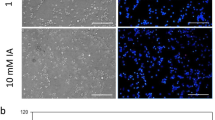Abstract
Using a specific fluorescent probe of mitochondrial membrane potential (tetramethylrhodamine ethyl ester), we have shown that glucose deprivation (GD) of cultured cerebellar granule neurons (CGN) for 3 h lowers mitochondrial membrane potential in these cells. Longer glucose starvation (24 h) causes CGN death that is not prevented by blockers of ionotropic glutamate receptors (MK-801 (10 μM) and NBQX (10 μM)). Glutamine or pyruvate (2 mM) maintain membrane potential of mitochondria and decrease CGN death under GD conditions. In the presence of glucose the mitochondrial respiratory chain blocker rotenone induces neuron death potentiated by glutamine. The potentiation effect is completely prevented by blockers of ionotropic glutamate receptors. These results show that glutamine under conditions of GD can be utilized by mitochondria as substrate, but at the same time, in the case of mitochondrial function deterioration, metabolism of this amino acid results in glutamate accumulation to toxic level.
Similar content being viewed by others
Abbreviations
- APV:
-
aminophosphonovalerate
- CGN:
-
cultured granule neurons
- GD:
-
glucose deprivation
- NBQX:
-
2,3-dioxo-6-nitro-1,2,3,4-tetra-hydrobenzoquinoxaline-7-sulfonamide
- NMDA:
-
N-methyl-D-aspartate
- MK-801:
-
(+)-5-methyl-10,11-dihydro-5H-dibenzo(a,d)cycloheptene-5,10-imino-maleate
- TMRE:
-
tetramethylrhodamine ethyl ester
References
Newcomb, R., Sun, X., Taylor, L., Curthoys, N., and Giffard, R. G. (1997) J. Biol. Chem., 272, 11276–11282.
Newcomb, R., Pierce, A. R., Kano, T., Meng, W., Bosque-Hamilton, P., Taylor, L., Curthoys, N., and Lo, E. H. (1998) Brain Res., 813, 103–111.
Goldberg, M. P., Monyer, H., and Choi, D. W. (1988) Neurosci. Lett., 94, 52–57.
Stelmashook, E. V., Isaev, N. K., and Zorov, D. B. (2007) Toxicol. Lett., 174, 82–88.
Monyer, H., and Choi, D. W. G. (1990) J. Cereb. Blood Flow Metab., 10, 337–342.
Peng, L., Gu, L., Zhang, H., Huang, X., Hertz, E., and Hertz, L. (2007) J. Neurosci. Res., 85, 3480–3486.
Auer, R. N., and Siesjo, B. K. (1993) Baillieres Clin. Endocrinol. Metab., 7, 611–625.
Sutherland, G. R., Tyson, R. L., and Auer, R. N. (2008) Med. Chem., 4, 379–385.
Ashmarin, I. P., Stukalova, P. V., Eshchenko, N. D., et al. (1999) in Brain Biochemistry (Ashmarin, I. P., Stukalova, P. V., and Eshchenko, N. D., eds.) [in Russian], St. Petersburg Publishing House, pp. 124–159.
Abdul-Ghani, A. S., Ghneim, H., El-Lati, S., and Saca’an, A. (1989) Int. J. Neurosci., 44, 67–74.
Honegger, P., Braissant, O., Henry, H., Boulat, O., Bachmann, C., Zurich, M. G., and Pardo, B. (2002) J. Neurochem., 81, 1141–1151.
Huang, R., and Hertz, L. (1994) Brain Res., 660, 129–137.
Isaev, N. K., Stelmashook, E. V., Dirnagl, W., Plotnikov, E. Yu., Kuvshinova, E. A., and Zorov, D. B. (2008) Biochemistry (Moscow), 73, 149–155.
Stelmashook, E. V., Isaev, N. K., Plotnikov, E. Y., Uzbekov, R. E., Alieva, I. B., Arbeille, B., and Zorov, D. B. (2009) Neurosci. Lett., 461, 140–144.
Bouvier, M., Szatkowski, M., Amato, A., and Attwell, D. (1992) Nature, 360, 471–474.
Petito, C. K., Chung, M. C., Verkhovsky, L. M., and Cooper, A. J. (1992) Brain Res., 569, 275–280.
Author information
Authors and Affiliations
Corresponding author
Additional information
Original Russian Text © E. V. Stelmashook, S. V. Novikova, N. K. Isaev, 2010, published in Biokhimiya, 2010, Vol. 75, No. 8, pp. 1150–1156.
Rights and permissions
About this article
Cite this article
Stelmashook, E.V., Novikova, S.V. & Isaev, N.K. Glutamine effect on cultured granule neuron death induced by glucose deprivation and chemical hypoxia. Biochemistry Moscow 75, 1039–1044 (2010). https://doi.org/10.1134/S0006297910080134
Received:
Revised:
Published:
Issue Date:
DOI: https://doi.org/10.1134/S0006297910080134



